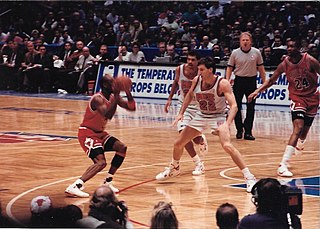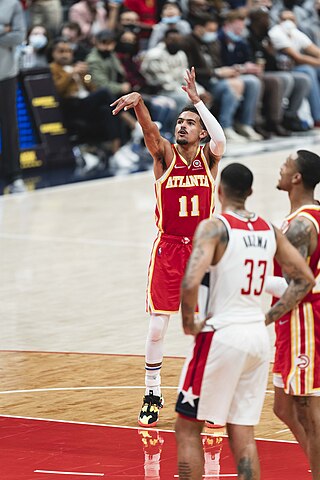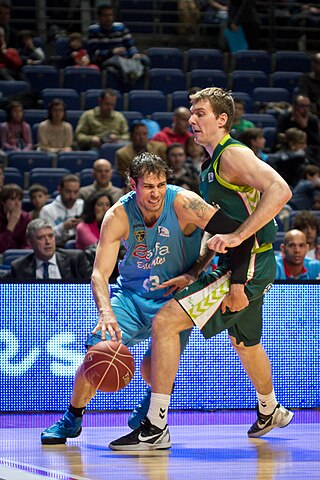Related Research Articles

Basketball is a team sport in which two teams, most commonly of five players each, opposing one another on a rectangular court, compete with the primary objective of shooting a basketball through the defender's hoop, while preventing the opposing team from shooting through their own hoop. A field goal is worth two points, unless made from behind the three-point line, when it is worth three. After a foul, timed play stops and the player fouled or designated to shoot a technical foul is given one, two or three one-point free throws. The team with the most points at the end of the game wins, but if regulation play expires with the score tied, an additional period of play (overtime) is mandated.

In basketball, the basketball court is the playing surface, consisting of a rectangular floor, with baskets at each end. Indoor basketball courts are almost always made of polished wood, usually maple, with 3.048 meters (10 ft)-high rims on each basket. Outdoor surfaces are generally made from standard paving materials such as concrete or asphalt. International competitions may use glass basketball courts.
In basketball, a technical foul is any infraction of the rules penalized as a foul which does not involve physical contact during the course of play between opposing players on the court, or is a foul by a non-player. The most common technical foul is for unsportsmanlike conduct. Technical fouls can be assessed against players, bench personnel, the entire team, or even the crowd. These fouls, and their penalties, are more serious than a personal foul, but not necessarily as serious as a flagrant foul.

A shot clock is a countdown timer used in a variety of games and sports, indicating a set amount of time that a team may possess the object of play before attempting to score a goal. Shot clocks are used in several sports including basketball, water polo, canoe polo, lacrosse, poker, ringette, korfball, tennis, ten-pin bowling, and various cue sports. It is analogous with the play clock used in American and Canadian football, and the pitch clock used in baseball. This article deals chiefly with the shot clock used in basketball.

In basketball, free throws or foul shots are unopposed attempts to score points by shooting from behind the free-throw line, a line situated at the end of the restricted area. Free throws are generally awarded after a foul on the shooter by the opposing team, analogous to penalty shots in other team sports. Free throws are also awarded in other situations, including technical fouls, and when the fouling team has entered the bonus/penalty situation. Also, depending on the situation, a player may be awarded between one and three free throws. Each successful free throw is worth one point.

In basketball, a personal foul is a breach of the rules that concerns illegal personal contact with an opponent. It is the most common type of foul in basketball. A player fouls out on reaching a limit on personal fouls for the game and is disqualified from participation in the remainder of the game.

A jump ball is a method used to begin or resume play in basketball. It is similar to a face-off in ice hockey and field lacrosse and a ball-up in Australian rules football. Two opposing players attempt to gain control of the ball after an official tosses it into the air between them.

The rules of basketball are the rules and regulations that govern the play, officiating, equipment and procedures of basketball. While many of the basic rules are uniform throughout the world, variations do exist. Most leagues or governing bodies in North America, the most important of which are the National Basketball Association and NCAA, formulate their own rules. In addition, the Technical Commission of the International Basketball Federation (FIBA) determines rules for international play; most leagues outside North America use the complete FIBA ruleset.

In basketball, there are five players on court per team, each assigned to positions. Historically, these players have been assigned to positions defined by the role they play on the court, from a strategic point of view. The three main positions are guard, forward, and center, with the standard team featuring two guards, two forwards, and a center. Over time, as more specialized roles developed, each of the guards and forwards came to be differentiated, and today each of the five positions is known by a unique name and number: point guard (PG) or 1, the shooting guard (SG) or 2, the small forward (SF) or 3, the power forward (PF) or 4, and the center (C) or 5 “post position”
Man-to-man defense, or man defense, is a type of defensive system used in team sports such as American football, association football, basketball and netball, as in which each player is assigned to defend and follow the movements of a single player on offense. Often, a player guards his counterpart, but a player may be assigned to guard a different position. However, the strategy is not rigid, and a player might switch assignment if needed, or leave his own assignment for a moment to double team an offensive player. The term is commonly used in both men's and women's sports. The alternative to man-to-man defense is zone defense, a system of defense in which each player guards an assigned area rather than a specified opponent.

In basketball, a flagrant foul is a personal foul that involves excessive or violent contact that could injure the fouled player. A flagrant foul may be unintentional or purposeful; the latter type is also called an "intentional foul" in the National Basketball Association (NBA). However, not all intentional fouls are flagrant fouls, as it is an accepted strategy to intentionally commit a foul in order to regain possession of the ball while minimizing how much time elapses on the game clock.

This glossary of basketball terms is a list of definitions of terms used in the game of basketball. Like any other major sport, basketball features its own extensive vocabulary of unique words and phrases used by players, coaches, sports journalists, commentators, and fans.

In basketball, a foul is an infraction of the rules more serious than a violation. Most fouls occur as a result of illegal personal contact with an opponent and/or unsportsmanlike behavior. Fouls can result in one or more of the following penalties:
The following terms are used in water polo. Rules below reflect the latest FINA Water Polo Rules.
In basketball, the five-second rule, or five-second violation, is a rule that helps promote continuous play. There are multiple situations where a five-second violation may occur.
Delay of game is an action in a sports game in which a player or team deliberately stalls the game, usually with the intention of using the delay to its advantage. In some sports, the delay of game is considered an infraction if it is longer than that permitted according to the game's rules, in which case a penalty can be issued. Some sports that have a delay of game penalty are American football, Canadian football, ice hockey and association football.

The key, officially referred to as the free throw lane by the National Basketball Association (NBA), the National Collegiate Athletic Association (NCAA), the National Association of Intercollegiate Athletics (NAIA), and the National Federation of State High School Associations (NFHS), and the restricted area by the International Basketball Federation (FIBA), is a marked area on a basketball court surrounding the basket, where much of the game's action takes place.
The following terms are used in American football, both conventional and indoor. Some of these terms are also in use in Canadian football; for a list of terms unique to that code, see Glossary of Canadian football.
Basketball is a ball game and team sport in which two teams of five players try to score points by throwing or "shooting" a ball through the top of a basketball hoop while following a set of rules. Since being developed by James Naismith as a non-contact game that almost anyone can play, basketball has undergone many different rule variations, eventually evolving into the NBA-style game known today. Basketball is one of the most popular and widely viewed sports in the world.
In basketball, a common violation is the most minor class of illegal action. Most violations are committed by the team with possession of the ball, when a player mishandles the ball or makes an illegal move. The typical penalty for a violation is loss of the ball to the other team. This is one type of turnover.
References
- ↑ Winderman, Ira (April 13, 2001). "NBA changes its rules to allow zone defense". Sun-Sentinel.com. Retrieved March 9, 2020.
- 1 2 "NBA Official Rule 10, Section VII". NBA.com. 15 October 2018. Retrieved March 9, 2020.
- ↑ Abrams, Jonathan (February 27, 2009). "Subtly, Zone Defense Helps Open Game". The New York Times– via NYTimes.com.
- ↑ "What is Defensive Three-Second Violation? Definition from SportingCharts.com". Archived from the original on 2013-03-17.
- ↑ Cruz, Agnes (January 24, 2003). "PBA get fresh look this season". Arab News . Retrieved January 13, 2014.
- ↑ "WNBA Announces Rules Changes for 2013 Season". WNBA. Retrieved Dec 16, 2012.
